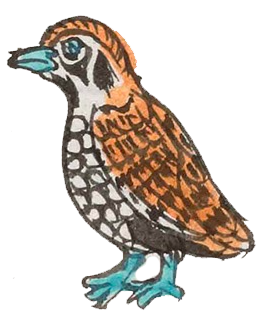Zollan (Mdz15v)
This simplex glyph for zolin (quail) doubles as the place name Zollan (also spelled Sula). It consists of a bird standing upright, in a profile, facing to the viewer's left. It has turquoise-colored feet, a turquoise beak, and a turquoise eye. The feathers on the top of its head and back are a terracotta-brown. There are also some black or dark gray-purple patches of feathers near the face and above the feet. The feathers on its chest and around its face are white.
Stephanie Wood
The locative suffix (-tlan, which changes to -lan before a stem ending in "l," as here) is not shown visually. According to the Encyclopedia Britannica, quails are short-tailed birds that can be any one of 130 species. The one in this glyph has a short tail. It does not have the signature curving crest or plume of the California quail. Rather, it resembles the Montezuma quail, or Cyrtonyx Montezumae. The zolin was one of the 13 quecholli, or "representatives of the 13 fate-bearers, each linked to the 13 sacred numbers in the ritual calendar" which included "13 rounds of 20 signs making 260 days," according to Ian Mursell of Mexicolore. The zolin, the 4th of the 13, was associated with the tonatiuh (sun).
Stephanie Wood
çulan_puo
Zollan, pueblo
Stephanie Wood
c. 1541, but by 1553 at the latest
Stephanie Wood
birds, quail, codornices, Çula, Sula, feathers, nombres de lugares, ave, aves, pájaro, pájaros, pluma, plumas, animals, animales

"Quail Place" [Frances Karttunen, unpublished manuscript, used here with her permission.]
"Where There Are Many Quails" (Berdan and Anawalt, 1992, vol. 1, p. )
"El Lugar de la Codorniz" o "El Lugar de os Codornices"
Stephanie Wood
Codex Mendoza, folio 15 verso, https://digital.bodleian.ox.ac.uk/objects/2fea788e-2aa2-4f08-b6d9-648c00..., image 41 of 188.
The Bodleian Libraries, University of Oxford, hold the original manuscript, the MS. Arch. Selden. A. 1. This image is published here under the UK Creative Commons, “Attribution-NonCommercial-ShareAlike 3.0 License” (CC-BY-NC-SA 3.0).


